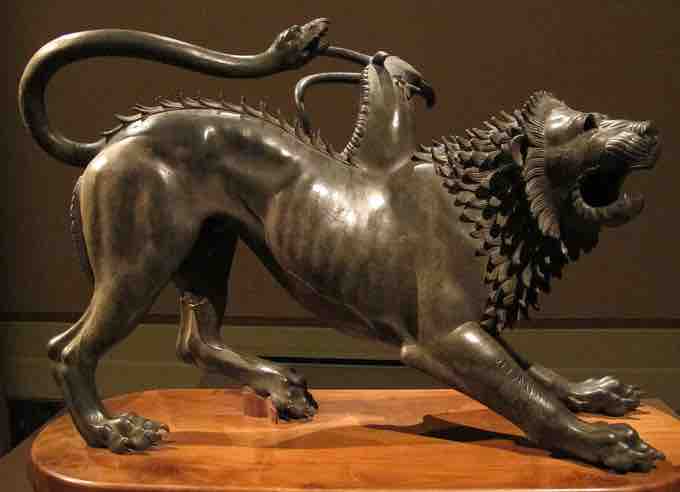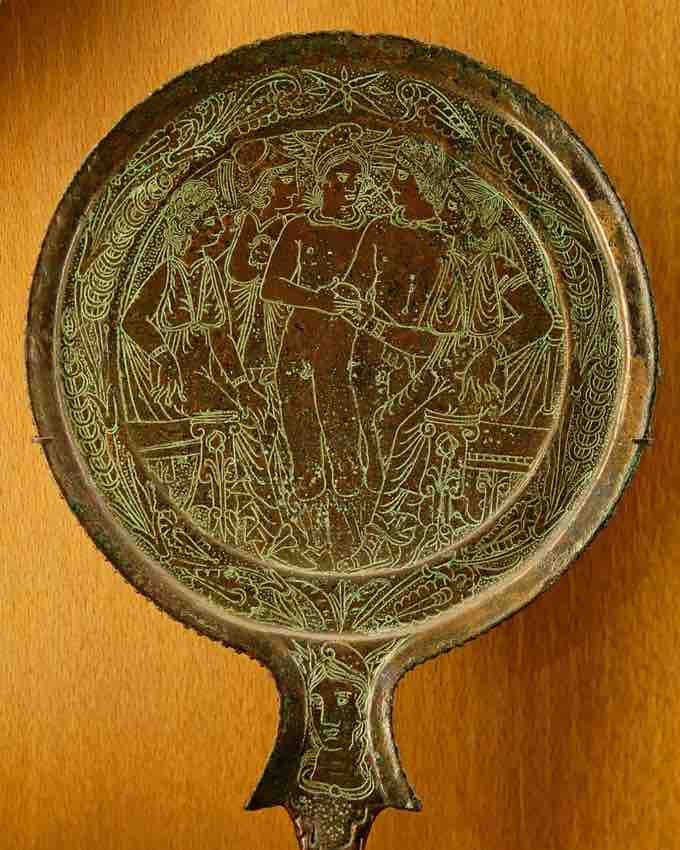During its Classical period, from 480 to 300 BCE, Etruscan art was known for its hollow cast bronze sculptures and smaller utilitarian objects. Objects such as mirrors and cistae were engraved or incised with rich imagery made noticeable by a white substance inserted into the outlines and contour lines. Sculptures of human subjects range from naturalistic to exaggerated, almost modernist, forms. Mythical creatures from the Greek and Eastern traditions commonly found their way into the subject matter. In total, Etruscan sculpture incorporates a variety of cultural styles and motifs, including Orientalizing, Archaic, and Classical. Very few Etruscan bronze sculptures survived from being melted down in the following centuries to be used for other purposes.
Lost-Wax Casting
Also known by its French name cire perdue, lost-wax casting is the oldest method of producing metal sculptures. Although any material that can be liquified and subsequently solidified may be cast, metal is the most common. Of all metals, bronze is the most commonly cast. In lost-wax casting, the sculptor begins by making a clay mold of the intended sculpture, coats it in wax, and applies an outer layer of plaster, fastening metal rods to hold the shell in place and wax rods to vent the mold. Intense heat is then applied, causing the wax to melt and flow out of the mold. This step leaves open channels into which molten metal is poured. When the metal has cooled and hardened, the mold is broken, the sculpture is removed, and the holes left from the pins and rods are filled and smoothed. Finally, the sculpture is polished and ready for display. Because the mold must be destroyed, sculptors use the lost-wax method to produce one-of-a-kind sculptures.
Chimera of Arezzo
The bronze statue of a Chimera , discovered in the city of Arezzo in 1553, has also recently been accused as a forgery. The reasoning rests more on the fact that there are no comparable existing Etruscan sculptures than on scientific testing. An inscription on the right foreleg marks the bronze as a votive offering to the supreme Etruscan god, Tinia (comparable to Roman Jupiter). The sculpture depicts a chimera, a mythical beast with the body and head of a lion, a serpent for a tail, and with a goat's head in the middle of its back. The beast plagued the area of Lycia until it was slain by the hero Bellerophon. The serpent tail was not discovered with the statue; the current tail is an eighteenth century restoration.

Chimera of Arezzo
Chimera of Arezzo. Bronze. Early 4th century BCE. Arezzo, Italy.
The bronze statue demonstrates Etruscan artistic techniques and liveliness, seen in Etruscan terra cotta sculpture, transmitted into the bronze medium. The figure is well modeled and expressive—from its tense muscles, ready pose, and roaring face of the lion and goat. The beast's ribs are clearly visible and a wound on its rump bleeds. The lion's posture, he crouches and looks up, suggest that there may have been an additional figure of Bellerophon to create a votive group. The figure's face and mane is stylized and the patterning is reminiscent of Near Eastern depictions of lions.
Ombra della sera
Produced in the metal-rich town of Velathri (later Volterra), the Ombra della sera (Italian for Evening Shadow) represents a male nude of nearly two feet high. Archaeologists estimate its date of production to the third century BCE. In ancient times, Volterra bronze workers were known for their ability to fuse copper ores with tin to form bronze. The body of the sculpture is very elongated, while the scale of its head is naturalistic. The title Ombra della sera was applied to the sculpture centuries later by a poet who likened its exaggerated form to shadows cast by the setting sun. These unusual proportions lead some experts to believe that the sculpture was intended as a votive offering.
Ombra della Sera
Bronze. c. third century BCE. Volterra.
Mars of Todi
The so-called Mars of Todi (late fifth-early fourth century BCE) is a nearly life-size bronze warrior produced as a votive offering, possibly to Laran, the Etrucscan god of war. The figure probably held a patera (libation bowl) in his extended right hand, and a spear in the left. His helmet is missing, but his body armor is one of the best surviving examples showing how plate armor from the period appeared. Unlike the Ombra della sera, the Mars of Todi is very naturalistic, complete with a dynamic contrapposto pose and inlaid eyes. A dedication that combines the Etruscan alphabet and Latin dialect from Umbria (central Italy) is inscribed on the skirt of the breastplate. It translates as, "Ahal Trutitis gave [this as a] gift." Interestingly, the name of the donor was Celtic in origin, denoting the cosmopolitan nature of the region in ancient times.
Mars of Todi
Bronze. c. late 5th-early 4th century BCE. Umbria.
Bronze Objects
The Etruscans also used bronze to create small objects, including storage jars, or cistae, and mirrors. Etruscan bronze mirrors were used by women and often deposited as grave goods. These mirrors were highly burnished on one side to reflect an image, and on the other side were decorated with engraved or low relief casted scenes. The images depicted were often scenes from Greek mythology, demonstrating the importation of Greek culture and mythology. Many of these mirrors were inscribed with the deceased's name, and ritual blessings.

Judgment of Paris
Mirror with an engraving of the Judgment of Paris. Bronze. 4th-3rd century BCE.
Cistae were also often inscribed and were also decorated with engravings and added bronze elements, such as feet, chains, and decorative handle lids. The cistae were small boxes with lids, much like a pyxis, that was made from bronze and was usually cylindrical. The handles of the lids were often figures, such as a man or a sphinx, or figural groups. Like the mirrors, the engraved scenes represented images from mythology, but some images also depict scenes from Etruscan history.

Cista with a battle between Etruscans and Gauls.
Cista with a battle between Etruscans and Gauls. Bronze. 3rd century BCE. Praeneste, Italy.